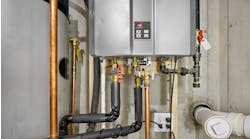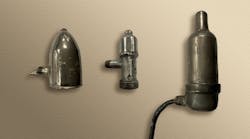When you think about it, there are quite a few different things that we run into when we look closely at an installed radiator. Frequently overlooked, that thing can make a big difference in the performance of that radiator and ultimately the performance of the system. In this column, I’ll only be discussing the things at the end of a one pipe steam radiator, on the side opposite of the steam supply. Next time, I’ll attempt to tackle all the things at the end of a two-pipe radiator.
It’s necessary to be that specific when you’re talking about a steam radiator, whether on a one-pipe system or a two-pipe system. A hot water radiator can be piped a number of ways, since it is full of water. However, a steam radiator should be full of steam, with a path to allow the air to escape and a path for the condensation to flow back to the boiler. Simple enough, what could go wrong?
Allowing the Air to Escape
The things on the end of a one-pipe radiator are there to allow the air to escape, since the water goes back though the supply valve. Steam won’t enter the radiator unless the air is leaving. The most common thing is the radiator air vent, typically tapped about a third of the way up from the floor on the end section. You don’t want it at the top, like a hot water radiator, since the lighter than air steam is at the top of the radiator. You also don’t want it at the bottom, since the condensation is at the bottom.
Cast iron radiator manufacturers decided a long time ago where that tapping would be. What would be screwed into that tapping was the pursuit of many different steam specialties manufacturers. Today there are only a few vent choices, while 100 years ago there were plenty. I still run across an ancient vent that I’ve never seen before.
Vent Types
The vents could be split into two varieties, automatic and vacuum. Both types could have an adjustment to the venting rate. The faster the venting rate, typically the hotter the radiator will become during a call for heat. The slower the venting rate, typically the cooler the radiator. The adjustment is to the size of the hole that the air releases through.
The automatic type air vent releases the air, closes off to prevent the release of steam, then opens again to the atmosphere to allow air to flow back into the radiator when steam is not present. This is the most common and is recommended for gas and oil fired systems that cycle on and off.
The vacuum type air vent releases the air to allow the radiator to fill with steam, closes off to prevent the release of steam, then causes the radiator to pull a vacuum when steam is not present with a built-in check valve of some sort, keeping the air from flowing back into the radiator and also the water from flowing back to the boiler. This was very popular during the coal-fired era, when boilers held a lot more water than they do today.
When this type of vent is causing a vacuum, it allowed the steam boiler to keep making steam as the coal fire cooled off overnight. Water under a vacuum makes steam at temperatures below the typical boiling point of 213F. Worked great and saved money, but only on hand-fired steam boilers of that era.
Today’s boilers hold a lot less water and keeping water up in the system causes flooding problems. Also, with automatic-fired boilers, the heat exchanger quickly cools below the boiling point, even under the vacuum. My advice, and the advice of many before me, is to remove any vents on automatic-fired systems that cause a vacuum and replace with automatic type vents. Let that open vent break any vacuum that might try to form to allow the condensate to flow freely back to the boiler.
Vacuum Variation
Sometimes the thing on the side of a one-pipe radiator kinda looks like a typical vent, but has a small pipe coming out the bottom that goes down through the floor. These are more likely found in commercial buildings, but I have also found them residentially. They are another take on the vacuum idea, only without the check valve.
The vacuum was produced in the basement and delivered to the radiator through that small pipe coming out of the floor. The vacuum pulled the steam to the radiator faster. The vent closed off when steam filled the radiator to prevent the steam from travelling to the vacuum producer in the basement. When the steam ceases to be present, the vent opens back up.
Ally Actuated
A further development of the one-pipe radiator vent is the thermostatic ally actuated air vent. The non-electric actuator senses the room temperature and closes off the air vent as the room approaches set point. This thing on the end of a radiator consists of a valve body that screws into the normal tapping, with an air vent and an actuator screwed into the body.
They look a bit bulky, but are quite effective in keeping rooms from overheating. Remember, you don’t use the radiator valve on a one-pipe steam radiator to balance temperature in a system. That valve has to be wide open or completely closed because the condensate is flowing out of the radiator while the steam is flowing in. If you restrict the area where that happens by closing off the valve, you cause water hammer and uneven heating.
Another detail for one-pipe radiators is the pitch. Make sure that the side with the thing is higher than the side with the supply valve so that water can flow freely out of the radiator. Over time, this type of radiator is prone to getting out of pitch. Keep your eyes open for strange things at the end of one-pipe radiators.
Patrick Linhardt is a forty-year veteran of the wholesale side of the hydronic industry who has been designing and troubleshooting steam and hot water heating systems, pumps and controls on an almost daily basis. An educator and author, he is currently Hydronic Manager at the Corken Steel Products Co.


